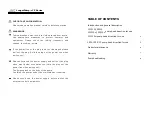
6
Important Safety Information
Introduction
All practical work areas and laboratories should be covered by local safety
regulations which must be followed at all times. If required Armfield can supply a
typical set of standard laboratory safety rules.
Your
S1 Drainage and Seepage Tank
has been designed to be safe in use, when
installed, operated and maintained in accordance with the instructions in this manual.
As with any piece of sophisticated equipment, dangers may exist if the equipment is
misused, mishandled or badly maintained. If the equipment is used in a manner not
specified by Armfield then the protection provided by the equipment may be
impaired.
The S1 is a heavy piece of equipment, and should be lifted fork lift if possible. Ensure
that the arms of the fork lift do not foul the sump moulding in the base of the unit. Do
not attempt to lift the unit when it is full of sand or water.
Electrical Safety
The equipment described in this Instruction Manual operates from a mains voltage
electrical supply. It must be connected to a supply of the same frequency and voltage
as marked on the equipment or the mains lead. If in doubt, consult a qualified
electrician or contact Armfield.
The equipment must only be connected to a mains supply with a reliable earth
connection so that the equipment is adequately earthed.
The equipment must only be operated using a fused electricity supply. Details of
required fuse ratings can be found on page 10.
The equipment must not be operated with any of the panels removed.
To give increased operator protection, the unit incorporates a Residual Current
Device (RCD), alternatively called an Earth Leakage Circuit Breaker, as an integral
part of this equipment. If through misuse or accident the equipment becomes
electrically dangerous, the RCD will switch off the electrical supply and reduce the
severity of any electric shock received by an operator to a level which, under normal
circumstances, will not cause injury to that person.
At least once each month, check that the RCD is operating correctly by pressing the
TEST button. The circuit breaker
MUST
trip when the button is pressed. Failure to
trip means that the operator is not protected and the equipment must be checked and
repaired by a competent electrician before it is used.
Accidents can be avoided
provided that equipment is
regularly maintained
and
staff
and
students
are made aware of potential hazards. A list of general safety
rules is included in this manual, to assist
staff
and
students
in this regard. The list is
not intended to be fully comprehensive but for guidance only.
Please refer to the following notes regarding the Control of Substances Hazardous to
Health Regulations.











































